Techno-Economic Optimization of a Solar–Wind Hybrid System to Power a Large-Scale Reverse Osmosis Desalination Plant
Abstract
:1. Introduction
- Process configurations are presented, design limits are investigated, and the mathematical model of the proposed systems is presented.
- The optimization method is performed to study the effect of cost minimization.
- A comparison of four cases (solar direct–three configurations vs. solar indirect–one configuration) is performed.
2. The Process Configurations
3. Simulation Methodology
4. Results and Comments
4.1. Non-Optimization Comparison Results
4.2. Comparison Results Based on Optimization
4.2.1. Technical Optimization Results
4.2.2. The Analytical Optimization Results
- It decreases the electrical load on the HPP unit;
- The operation proceeds without any need for more pressure vessels or membranes;
- The gain power is fully loaded on the PEX unit without any excess power from the brine loss.
- The PV module power and number of HWTs,
- The total productivity with respect to the inlet feed/splitter ratio, and
- The site operating conditions, which decide the number of HWTs in the farm based on the power of each turbine.
4.3. Data Results Compared with Solar-ORC
5. Conclusions
- Reducing the inlet feed/splitter ratio to 10% to more than triple the demanded power by the HPP (390 to 1532 kW).
- Using fewer than two HWTs for this kind of an operation because increasing the number of wind turbines (low power per unit) increases the UPC.
- Selecting a PV module that minimizes UPC. The results revealed that the PV 35 W module was the best choice with a feed/splitter ratio of more than 70%, whereas the PV 280 W module increased the UPC. The PV 35 W UPC was about 0.517 USD/m3.
- Maintaining less than a 5% load on the HWT farm to minimize UPC. For both operations, increasing the load percentage meant increasing the dependent load on the farm, and this work confirmed that was UPC is minimized when the load percentage was less than 5%; i.e., fully operational by the PV solar field. This operation gave a remarkable UPC of about 0.518 USD/m3.
- Reducing the capital costs of PV panels to reduce the UPC so that it can compete with thermal systems. In a comparison with S-ORC-RO, the UPC of the PV-RO system was lower than that of the CSP-RO system; however, it may increase if the operation generates power over 10 MWe.
6. Recommendations
Author Contributions
Funding
Institutional Review Board Statement
Informed Consent Statement
Data Availability Statement
Acknowledgments
Conflicts of Interest
Nomenclature
| A | Area: m2 |
| Ac | Cell area, m2 |
| Ae | Element area, m2 |
| AH | Battery capacity, Ah |
| Am | Module area, m2 |
| Ar | Rotor swept area m2 |
| At | Total area, m2 |
| BS | Battery storage, Wh |
| Cb | Battery cost, USD |
| Ct | Total cost, USD |
| CP | Turbine power coefficent |
| DCC | Direct capital cost, USD |
| DOD | Depth of discharge |
| Dr | Rotor diameter, m |
| FF | Fouling factor |
| FOBc | Full over board cost, USD |
| Gb | Solar flux, W/m2 |
| HPP | High pressure pump |
| Hh | Hub height, m |
| HWT | Horizontal wind turbine |
| k | Permeability |
| M | Mass flow rate, m3/h, kg/s |
| n | Number, # |
| ne | Element number |
| NV | Number of pressure vessels |
| NOB | Number of batteries, # |
| NOC | Number of cells, # |
| NOM | Number of modules, # |
| NWT | Number of wind turbines, # |
| OH | Operating hours, h |
| P | Power, Permeator, or Pressure, bar |
| Pm | Module power, W |
| Pt | Total power, W |
| Pw | Wind power, kW |
| PV | Photovoltaic |
| ΔP | Pressure, bar |
| RR | Recovery ratio |
| RPMr | Rotor speed, rpm |
| SPC | Specific power consumption, kWh/m3 |
| SR | Salt rejection |
| T | Temperature, °C |
| Tor | Torque, Nm |
| TCF | Temperature correction factor |
| UPC | Unit product cost, USD/m3 |
| V | Volt |
| Vws | Start wind speed, m/s |
| Vwa | Average wind speed, m/s |
| X | Salinity, ppm |
| Subscripts | |
| air | Ambient |
| b | Brine, battery |
| c | Cell |
| d | Distillate product |
| e | Element |
| f | Feed |
| m | Module |
| ORC | Organic rankine cycle |
| RO | Reverse osmosis |
| t | Turbine, total |
| v | Vessel |
| w | Water |
| Greek | |
| η | Efficiency, % |
| Π | Osmotic pressure, kPa |
| ρ | Density, kg/mr |
| ω | Rad/s |
Appendix A
| Inputs: | Outputs: |
|---|---|
| 1—Operating hours (OH), h 2—Solar flux (Gb), W/m2 3—Number of cloudy days factor 4—System total power (Pt), kW 5—Module power (Pm) (5–280 W) 6—Battery depth of discharge (DOD) 7—Battery voltage (Vb), Volt 8—Battery efficiency, % 9—Battery unit price (Cb), USD | 1—Open circuit voltage (Voc), Volt 2—Short circuit current (Isc), A 3—Maximum voltage (Vm), Volt 4—Maximum current (Im), A 5—Cell and Module efficiencies, % 6—Net weight, kg 7—The dimensions, m2 8—Module price, USD/W 9—Number of cells and modules (NOC) 10—Cell area (Ac), cm2 11—Module area (Am), m2 12—Total system area (At), m2 13—Battery storage, Wh 14—Battery capacity, Ah 15—Number of batteries (NOB) 16—Full over board cost (FOBc), USD. |


References
- Lamei, A.; van der Zaag, P.; von Münch, E. Basic cost equations to estimate unit production costs for RO desalination and long-distance piping to supply water to tourism-dominated arid coastal regions of Egypt. Desalination 2008, 225, 1–12. [Google Scholar] [CrossRef] [Green Version]
- Nafey, A.; Sharaf, M. Combined solar organic Rankine cycle with reverse osmosis desalination process: Energy, exergy, and cost evaluations. Renew. Energy 2010, 35, 2571–2580. [Google Scholar] [CrossRef]
- Mark, W.; Craig, B. Optimization of seawater RO systems design. Desalination 2005, 173, 1–12. [Google Scholar]
- Qasim, M.; Badrelzaman, M.; Darwish, N.N.; Darwish, N.A.; Hilal, N. Reverse osmosis desalination: A state-of-the-art review. Desalination 2019, 459, 59–104. [Google Scholar] [CrossRef] [Green Version]
- Mohamed, E.S.; Papadakis, G.; Mathioulakis, E.; Belessiotis, V. A direct coupled photovoltaic seawater reverse osmosis desalination system toward battery based systems—a technical and economical experimental comparative study. Desalination 2008, 221, 17–22. [Google Scholar] [CrossRef]
- Helal, A.; Al-Malek, S.; Al-Katheeri, E. Economic feasibility of alternative designs of a PV-RO desalination unit for remote areas in the United Arab Emirates. Desalination 2008, 221, 1–16. [Google Scholar] [CrossRef]
- Manolakos, D.; Mohamed, E.; Karagiannis, I.; Papadakis, G. Technical and economic comparison between PV-RO system and RO-Solar Rankine system. Case study: Thirasia island. Desalination 2008, 221, 37–46. [Google Scholar] [CrossRef]
- Ahmad, G.; Schmid, J. Feasibility study of brackish water desalination in the Egyptian deserts and rural regions using PV systems. Energy Convers. Manag. 2002, 43, 2641–2649. [Google Scholar] [CrossRef]
- Tzen, E.; Perrakis, K.; Baltas, P. Design of a stand alone PV-desalination system for rural areas. Desalination 1998, 119, 327–333. [Google Scholar] [CrossRef]
- Liu, C.; Xia, W.; Park, J. A wind-driven reverse osmosis system for aquaculture wastewater reuse and nutrient recovery. Desalination 2007, 202, 24–30. [Google Scholar] [CrossRef]
- de la Nuez Pestana, I.; Latorre, F.J.G.; Espinoza, C.A.; Gotor, A.G. Optimization of RO desalination systems powered by renewable energies. Part I Wind. Energy. Desalination 2004, 160, 293–299. [Google Scholar]
- Dehmas, D.A.; Kherba, N.; Hacene, F.B.; Merzouk, N.K.; Merzouk, M.; Mahmoudi, H.; Goosen, M.F. On the use of wind energy to power reverse osmosis desalination plant: A case study from Ténès (Algeria). Renew. Sustain. Energy Rev. 2011, 15, 956–963. [Google Scholar] [CrossRef]
- García-Rodríguez, L.; Romero-Ternero, V.; Camacho, C.G. Economic analysis of wind-powered desalination. Desalination 2001, 137, 259–265. [Google Scholar] [CrossRef]
- Romero-Ternero, V.; García-Rodríguez, L.; Gómez-Camacho, C. Thermoeconomic analysis of wind powered seawater reverse osmosis desalination in the Canary Islands. Desalination 2005, 186, 291–298. [Google Scholar] [CrossRef]
- Ma, Q.; Lu, H. Wind energy technologies integrated with desalination systems: Review and state-of-the-art. Desalination 2011, 277, 274–280. [Google Scholar] [CrossRef]
- Dimitriou, E.; Boutikos, P.; Mohamed, E.S.; Koziel, S.; Papadakis, G. Theoretical performance prediction of a reverse osmosis desalination membrane element under variable operating conditions. Desalination 2017, 419, 70–78. [Google Scholar] [CrossRef]
- Ruiz-García, A.; Nuez, I. Performance evaluation and boron rejection in a SWRO system under variable operating conditions. Comput. Chem. Eng. 2021, 153, 107441. [Google Scholar] [CrossRef]
- Ruiz-García, A.; Nuez, I. Long-term intermittent operation of a full-scale BWRO desalination plant. Desalination 2020, 489, 114526. [Google Scholar] [CrossRef]
- Nafey, A.S.; Sharaf, M.A.; García-Rodríguez, L. A new visual library for design and simulation of solar desalination systems (SDS). Desalination 2010, 259, 197–207. [Google Scholar] [CrossRef]
- Delgado-Torres, A.M.; García-Rodríguez, L. Preliminary assessment of solar organic Rankine cycles for driving a desalination system. Desalination 2007, 216, 252–275. [Google Scholar] [CrossRef]
- Nafey, A.; Sharaf, M.; Rodríguez, M.D.L.G. Thermo-economic analysis of a combined solar organic Rankine cycle-reverse osmosis desalination process with different energy recovery configurations. Desalination 2010, 261, 138–147. [Google Scholar] [CrossRef]
- Sharaf, M.A.; Nafey, A.S.; García-Rodríguez, L. Exergy and thermo-economic analyses of a combined solar organic cycle with multi effect distillation (MED) desalination process. Desalination 2011, 272, 135–147. [Google Scholar] [CrossRef]
- Toh, K.Y.; Lianga, Y.Y.; Lau, W.J.; Weihs, G.A.F. The techno-economic case for coupling advanced spacers to high-permeance RO membranes for desalination. Desalination 2020, 491, 114534. [Google Scholar] [CrossRef]
- El-Dessouky, H.T.; Ettouney, H.M. Fundamental of Salt Water Desalination; Elsevier Science: Amsterdam, The Netherlands, 2002. [Google Scholar]
- Eldean, M.A.S. Design and Simulation of Solar Desalination Systems. Ph.D. Thesis, Suez Canal University, Suez, Egypt, 2011. [Google Scholar]
- Soliman, A.M.; Eldean, M.A.S.; Miraouia, I. Experimental and Economical Analysis of an Autonomous Renewable Power Supply System for Water Desalination and Electric Generation. Mod. Appl. Sci. 2019, 13, 43–64. [Google Scholar] [CrossRef] [Green Version]
- Soliman, A.M.; Al-Falahi, A.; Mohamed AEldean, S.; Elmnifi, M. A new system design of using solar dish-hydro combined with reverse osmosis for sewage water treatment: Case study Al-Marj, Libya. Desalination Water Treat. 2020, 193, 189–211. [Google Scholar] [CrossRef]
- Eldean, M.A.S.; El Shahat, A.; Soliman, A.M. A new modeling technique based on performance data for photovoltaic modules and horizontal axis wind turbines. Wind. Eng. 2017, 209–229. [Google Scholar]
- Ansari, M.; Mudhar, A.; Obaidi, A.; Hadadian, Z.; Moradi, M.; Haghighi, A.; Mujtaba, I.M. Performance evaluation of a brackish water reverse osmosis pilot-plant desalination process under different operating conditions: Experimental study. Clean. Eng. Technol. 2021, 4, 100134. [Google Scholar] [CrossRef]
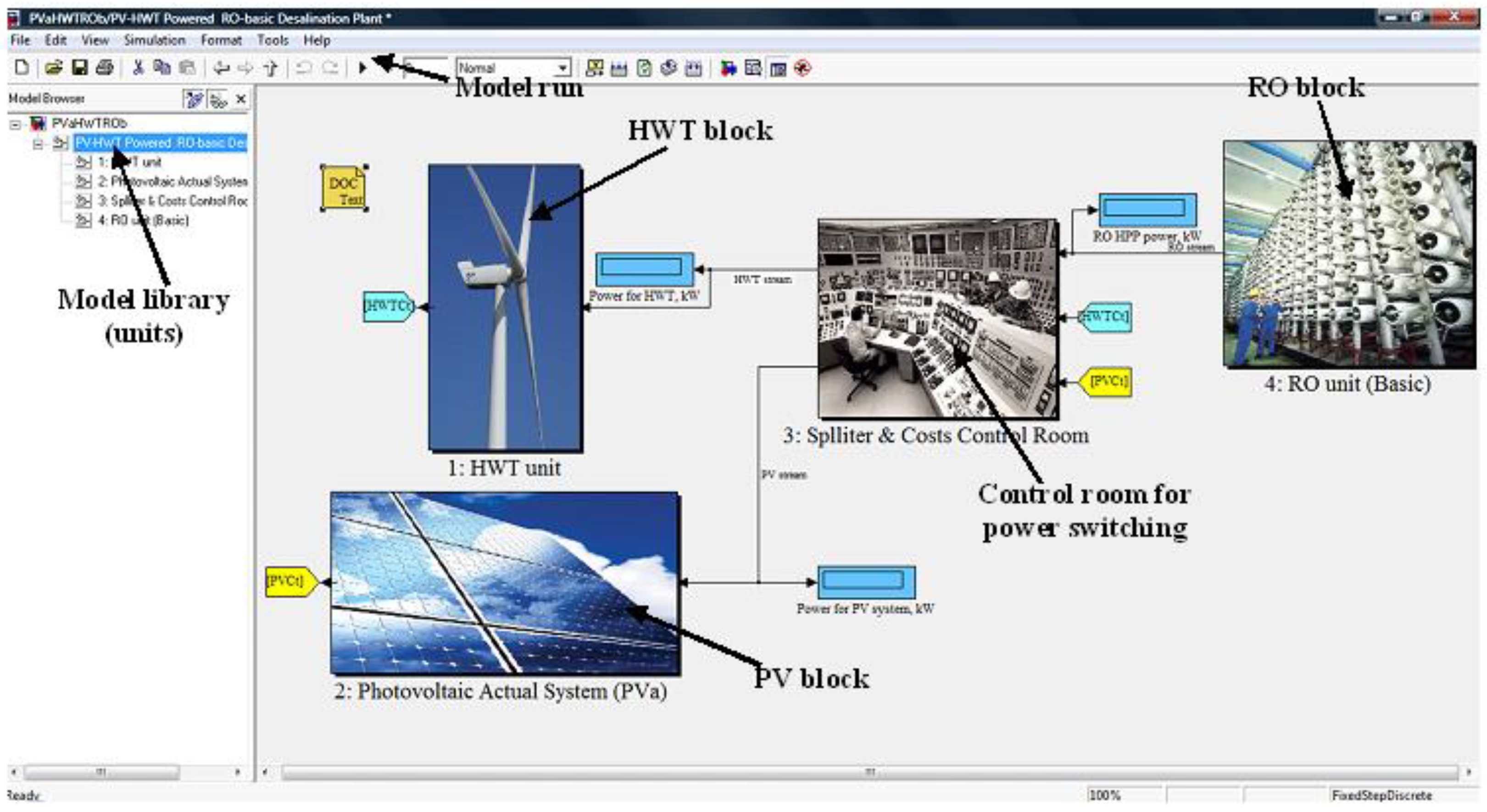

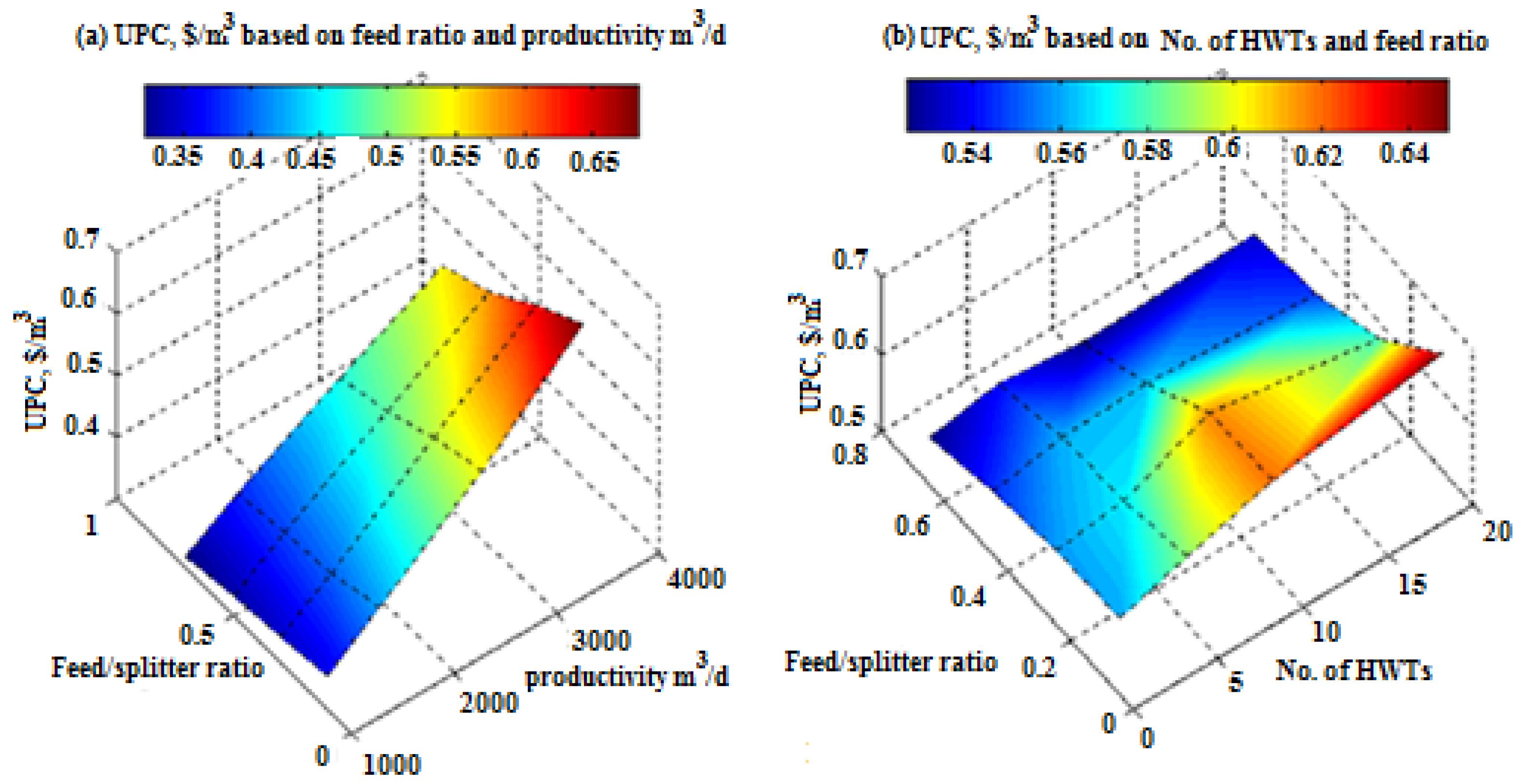
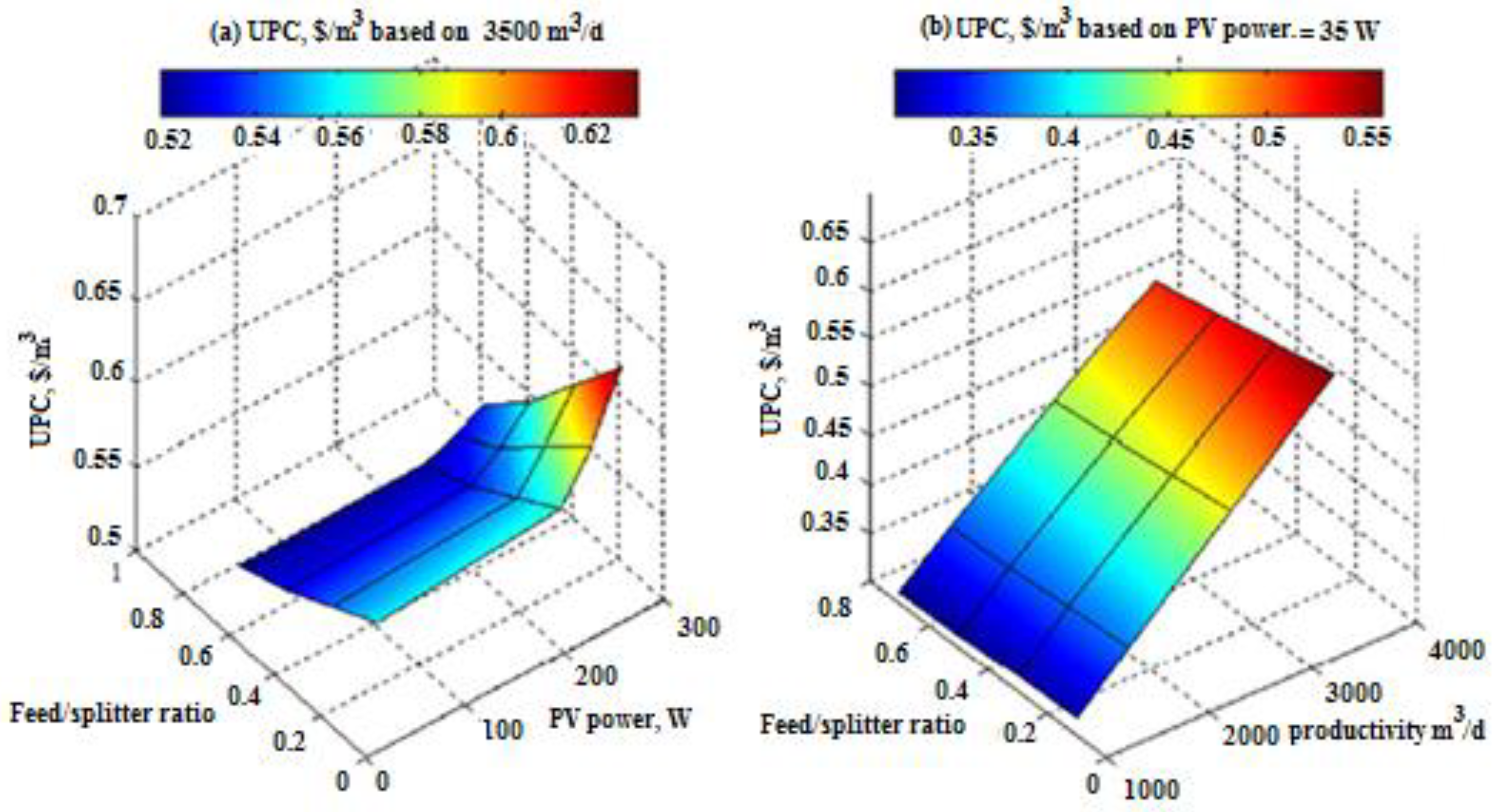
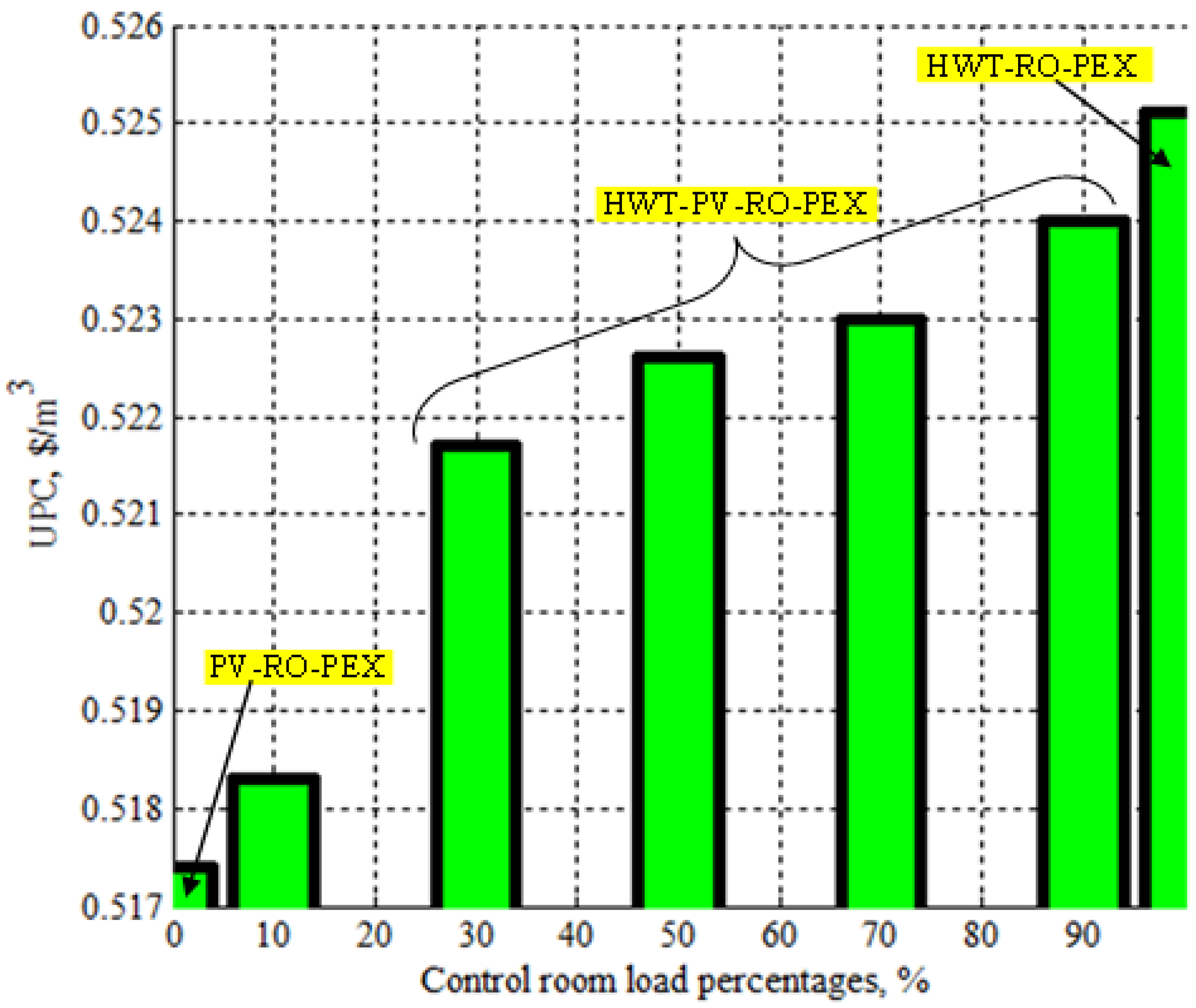
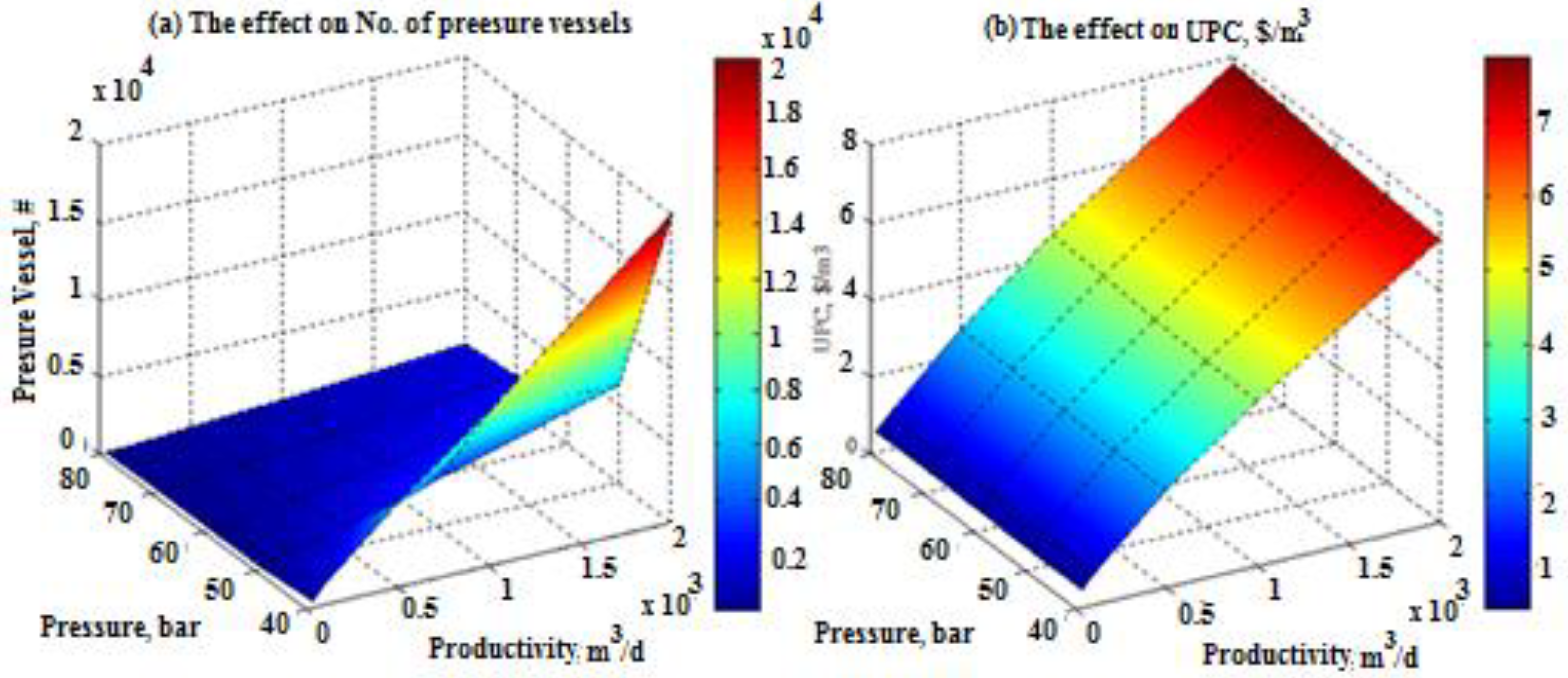

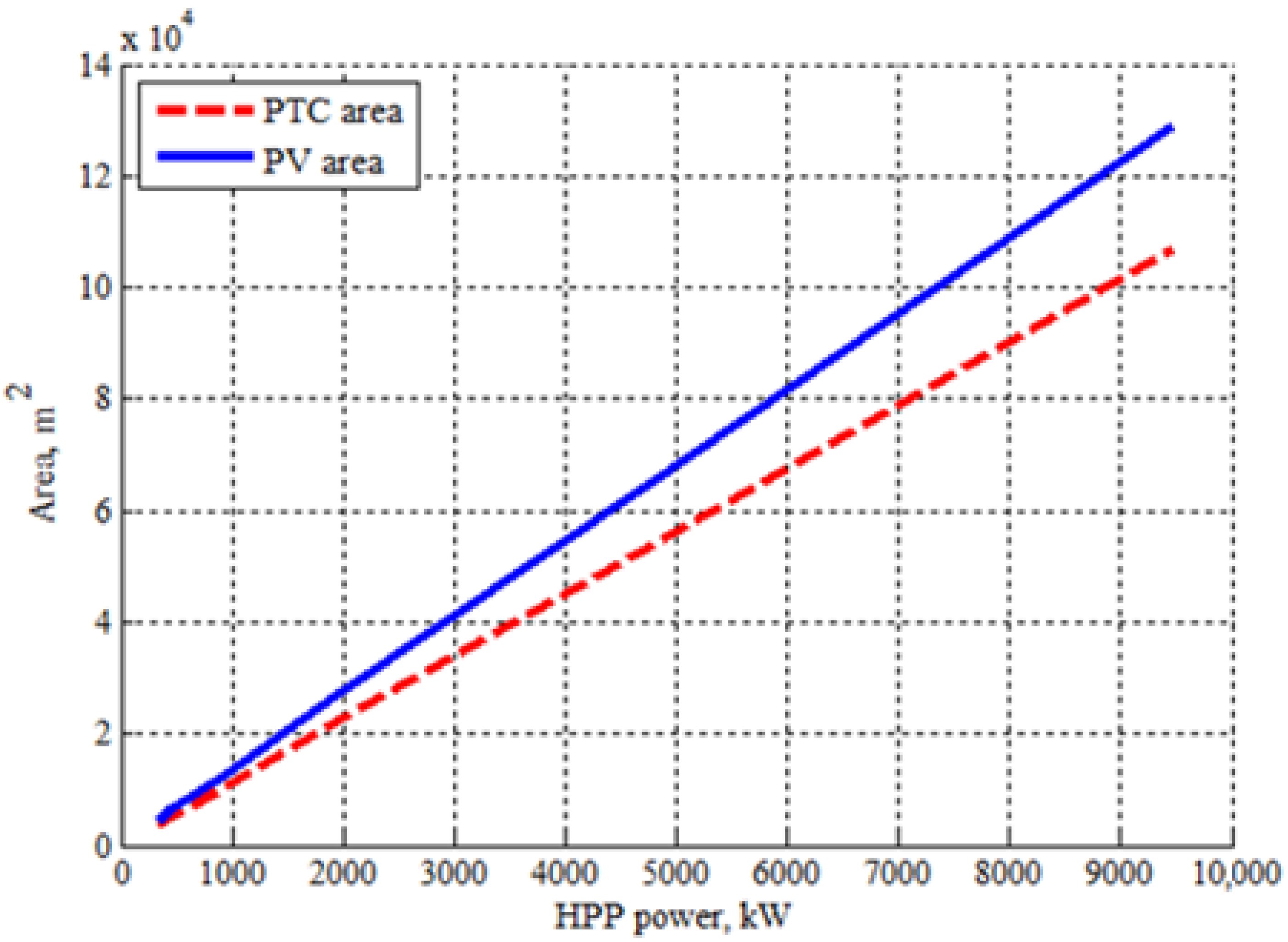

| RO Model | |
| Specified | Calculated |
| Fresh water productivity, m3/day | Feed and brine mass flow rates, kg/s |
| Seawater temperature, °C | Pressure on the HPP, bar |
| Seawater salinity, ppm | Average pressure, bar |
| HPP efficiency, % | Product and brine salinities, ppm |
| Booster pump efficiency, % | Salt rejection percentage, % |
| Membrane fouling factor, % | HPP power, kW |
| Number of elements/number of pressure vessels | SPC, kWh/m3 |
| Element area, m2 | Membrane area, m2 |
| Recovery ratio, % | |
| Pressure exchanger (PEX) efficiency, % | |
| HWT Model | |
| Specified | Calculated |
| Power/set, kW | Starting and average wind speeds, m/s, and air mass flow, kg/s |
| System total power, kW | Rotor diameter, m |
| Ambient temperature, °C | Hub height, m |
| Ambient pressure, bar | Rotor speed, rpm |
| Swept area, m2 | |
| Axial force, kN and Torque, kN | |
| Power coefficient, % | |
| Number of wind turbines | |
| Spacing between turbines in winddirection, m | |
| Spacing cross turbines in wind direction, m | |
| Total farm area, km2 | |
| PV Module | |
| Specified | Calculated |
| Solar radiation, W/m2 | The open circuit voltage, V and the short circuit current, A |
| Power/panel, W | The maximum voltage and current |
| Total system power, kW | The cell and module efficiencies, % |
| The number of cells and modules of the system | |
| The module and system weights, kg, and areas, m2 | |
| The battery bank capacity, A | |
| S-ORC Model | |
| Specified | Calculated |
| Solar radiation, W/m2 | Solar Fields, condenser, recuperator areas, m2 |
| Parabolic trough collector (PTC) high temperature, °C | Solar field dimensions and design |
| Boiler heat exchanger (BHX) effectiveness, % | Mass flow rates, kg/s |
| ORC turbine efficiency, % | ORC mass flow rates, kg/s |
| Recuperator effectiveness, % | Solar field mass flow rate, loop design, No. of collectors |
| Condensation temperature, °C | Heat rejected power, kW |
| Condenser effectiveness, % | PTC pump power, kW |
| All thermo physical properties of all streams | |
| Environmental Conditions | |
| Ambient temperature, °C | 15 (winter) |
| Solar radiation, W/m2 | 350–400 (winter) [22] |
| Air pressure, bar | 1.01 |
| Seawater temperature, °C | 20 |
| RO Plant Results | |
| Specific power consumption, kWh/m3 | 7.68 |
| Power, kW | 1131 |
| Feed mass flow rate, m3/h | 485.9 |
| Production flow rate, m3/h | 145.83 |
| Brine flow rate, m3/h | 340.1 |
| Brine salinity, ppm | 64180 |
| Fresh water salinity, ppm | 250 |
| Salt rejection value | 0.9944 |
| RO high pressure, kPa | 6850 |
| HWT Farm Results | |
| Total power for RO plant, kW | 1131 |
| Turbine power/wind power, kW | 600/4762 |
| Starting wind speed, m/s | 4–11.95 |
| Rated wind speed, m/s | 17.62 |
| Hub height, m | 41.6 |
| Rotor diameter, m | 43.32 |
| Swept area, m2 | 1474.08 |
| Air mass flow rate, kg/s | 3.173 × 106 |
| Torque (Nm)/rpm | 1.542 × 105/37.15 |
| No. of wind turbines | 2 |
| Farm area, km2 | 0.06368 |
| Cost Results | |
| Plant life time/interest rate | 25/5% |
| DCC of wind turbines, USD | 1.174 × 106 |
| DCC of RO plant, USD | 3.5 × 106 |
| Annual total costs, USD/year | 6.31 × 105 |
| Unit product costs, USD/m3 | 0.5541 |
| Environmental Conditions | |
| The environmental conditions | Presented in Table 2 |
| RO Plant Results | |
| The RO results | Presented in Table 2 |
| PV Site Results | |
| Open circuit voltage/short circuit current, V/A | 58.6/8.49 |
| Maximum voltage/maximum current, V/A | 47.4/4.641 |
| Module efficiency/cell efficiency, %/% | 15.45/17.5 |
| No. of cells per module/No. of total modules | 96/5135 |
| Module dimensions/width, m3/mm | 0.095/45 |
| Net weight, kg | 21.5 |
| Cell area/module area, cm2/m2 | 423.8/4.06 |
| Total system area, km2 | 0.02089 |
| Battery storage, Wh | 3.766 × 106 |
| Battery capacities, Ah | 7.945 × 104 |
| No. of batteries—12 volt system | 4 |
| Cost Results | |
| Plant life time/interest rate | 25/5% |
| DCC of PV, USD | 7.912 × 105 |
| DCC of RO plant, USD | 3.5 × 106 |
| Annual total costs, USD/year | 6.099 × 105 |
| Unit product costs, USD/m3 | 0.5305 |
| Environmental Conditions | |
| The environmental conditions | Presented in Table 2 |
| RO Plant Results | |
| The RO results | Presented in Table 2 |
| HWT Farm Results | |
| Total power for RO plant, kW | 1131 |
| Turbine power/wind power, kW | 100/596.2 |
| Starting wind speed, m/s | 5.6 |
| Rated wind speed, m/s | 14.77 |
| Hub height, m | 20.03 |
| Rotor diameter, m | 19.64 |
| Swept area, m2 | 303.1 |
| Air mass flow rate, kg/s | 5467 |
| Torque (Nm)/rpm | 1.288 × 104/74.14 |
| No. of wind turbines | 6 |
| Farm area, km2 | 0.03924 |
| PV Site Results | |
| Open circuit voltage/short circuit current, V/A | 58.6/8.49 |
| Maximum voltage/maximum current, V/A | 47.4/4.641 |
| Module efficiency/cell efficiency, %/% | 15.45/17.5 |
| No. of cells per module/No. of total modules | 96/5135 |
| Module dimensions/width, m3/mm | 0.095/45 |
| Net weight, kg | 21.5 |
| Cell area/module area, cm2/m2 | 423.8/4.06 |
| Total system area, km2 | 0.01045 |
| Battery storage, Wh | 1.88 × 106 |
| Battery capacities, Ah | 3.97 × 104 |
| No. of batteries (12 volt system) | 4 |
| Cost Results | |
| Plant life time/interest rate | 25/5% |
| DCC of HWT, USD | 1.1 × 106 |
| DCC of PV, USD | 3.958 × 105 |
| DCC of RO plant, USD | 3.5 × 106 |
| Annual total costs, USD/year | 6.604 × 105 |
| Unit product costs, USD/m3 | 0.5744 |
| Parameter: | Power, kW | SPC, kWh/m3 | RO ΔP, bar | Power Reduction, % |
|---|---|---|---|---|
| Basic | 1131 | 7.7 | 68.66 | -- |
| Stages = 9 | 917.47 | 6.3 | 35.8 | 18–20% |
| PEX | 380–394 | 2.704 | 68.74 | 60–65% |
| Parameter | CSP (Thermal) | PV (Electric) |
|---|---|---|
| Resource quality | 2400 kWh/m2/year | 2445 kWh/m2/year |
| Power type | Thermal (indirect) | Electrical (direct) |
| Desalination system to combine with | All types (MSF, MED, MED–TVC, MED-MVC, RO, ED | RO, MED-MVC |
| Levelised cost of energy USD/MWh | 60–350 (USD 214 in 2030) | 100–450 (USD 303 in 2030) |
| Construction period/life time | 2/30 years | 1/30 years |
| Capacity factor | 23–50% | 20% |
| Power production | 600 MW | 10 MW |
| Heat engines | Stirling, Rankine, gas turbines, steam turbines | N/A |
Publisher’s Note: MDPI stays neutral with regard to jurisdictional claims in published maps and institutional affiliations. |
© 2021 by the authors. Licensee MDPI, Basel, Switzerland. This article is an open access article distributed under the terms and conditions of the Creative Commons Attribution (CC BY) license (https://creativecommons.org/licenses/by/4.0/).
Share and Cite
Soliman, A.M.; Alharbi, A.G.; Sharaf Eldean, M.A. Techno-Economic Optimization of a Solar–Wind Hybrid System to Power a Large-Scale Reverse Osmosis Desalination Plant. Sustainability 2021, 13, 11508. https://doi.org/10.3390/su132011508
Soliman AM, Alharbi AG, Sharaf Eldean MA. Techno-Economic Optimization of a Solar–Wind Hybrid System to Power a Large-Scale Reverse Osmosis Desalination Plant. Sustainability. 2021; 13(20):11508. https://doi.org/10.3390/su132011508
Chicago/Turabian StyleSoliman, A. M., Abdullah G. Alharbi, and Mohamed A. Sharaf Eldean. 2021. "Techno-Economic Optimization of a Solar–Wind Hybrid System to Power a Large-Scale Reverse Osmosis Desalination Plant" Sustainability 13, no. 20: 11508. https://doi.org/10.3390/su132011508
APA StyleSoliman, A. M., Alharbi, A. G., & Sharaf Eldean, M. A. (2021). Techno-Economic Optimization of a Solar–Wind Hybrid System to Power a Large-Scale Reverse Osmosis Desalination Plant. Sustainability, 13(20), 11508. https://doi.org/10.3390/su132011508






